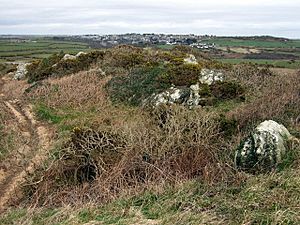Clegyr Boia facts for kids

Clegyr Boia. The eastern end of the hillfort/rock mound looking eastwards, towards the city of St Davids
|
|
| Alternative name | Clegyr Fwya |
|---|---|
| Location | near St Davids, Pembrokeshire, Wales |
| Coordinates | 51°52′43″N 5°17′19″W / 51.8785°N 5.2885°W |
| Type | Settlement, Hillfort |
| History | |
| Periods | Neolithic, Iron Age |
| Cultures | Celtic Brittonic |
| Site notes | |
| Excavation dates | 1902, 1943 |
| Archaeologists | Sabine Baring-Gould (1902), Audrey Williams (1943) |
| Condition | excavated site |
| Public access | Yes |
| Website | Coflein |
Clegyr Boia, also known as Clegyr Fwya, is a very old site in Pembrokeshire, Wales. It's on a rocky hilltop near St Davids, about 1 mile (1.6 km) to the west. This special place shows signs of people living there long, long ago.
Archaeologists have found proof of settlements from two important times: the Neolithic (New Stone Age) and the Iron Age. The hilltop is quite high, standing about 33 to 65 feet (10 to 20 meters) above the land around it.
The people who lived here got their water from a spring called Ffynnon Lygaid. This small pool was about 1 foot (0.3 meters) deep. Experts like Sabine Baring-Gould (in 1902) and Audrey Williams (in 1943) have dug here to learn more about its past.
Later, around the 6th century CE, an Irish pirate named Boia took over this rocky spot. That's how the site got its name, combining "Clegyr" (which means "crag" or "rocky hill") with Boia's name.
Life in the Neolithic Age
Finding proof of Neolithic settlements in Wales is quite rare. Usually, only large stone burial chambers from this time have survived. But at Clegyr Boia, archaeologists found something special: the remains of homes!
During an excavation in 1903, Sabine Baring-Gould found traces of both rectangular and circular houses. Near these homes, they found a "midden," which is like an ancient rubbish dump. This midden dates back about 5,500 years ago, to the early or middle Neolithic period.
What else did they find?
- Pieces of round-bottomed pottery.
- Smooth, polished stone axes.
- Bones from animals.
Even though no fireplaces were found inside the homes, there were "substantial" charcoal deposits. This shows that people used fire carefully at the site. These discoveries help us understand how early people lived in Wales.
The Iron Age Hillfort
During the Iron Age, Clegyr Boia became a strong defensive place known as a hillfort. The natural steep sides of the hill were made even stronger with a single earthen wall, called a rampart. This rampart helped protect the people living inside.
The southern part of the rocky area was also enclosed by stone walls. These walls were roughly rectangular, measuring about 280 feet (85 meters) long and 100 feet (30 meters) wide.
Here are some facts about the walls:
- They were built as "dry-stone" walls, meaning they used stones and earth without mortar.
- The ramparts stood about 2.5 feet (0.75 meters) above the ground inside the enclosure.
- The walls were strengthened with large stone blocks on the outside.
- They varied in width from 9 feet (2.7 meters) to 15 feet (4.5 meters).
It's thought that the entrance to this strong enclosure might have been through a tunnel. Samples taken from near the hillfort entrance suggest it was used around 1950 years ago (about 1 BCE), during the late Iron Age. This shows how people adapted the natural landscape for protection.

